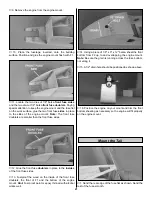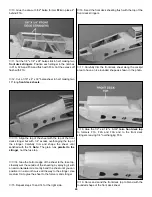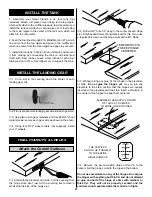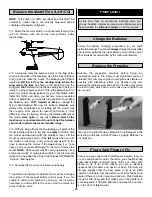
NOTE: This section is VERY important and must NOT be
omitted! A model that is not properly balanced will be
unstable and possibly unflyable.
❏
1. Mount the receiver switch in a convenient location that
will not interfere with the servos and pushrods inside
the fuselage.
❏
2. Accurately mark the balance point on the top of the
wing on both sides of the fuselage. Use thin strips of tape or
a felt tip pen to make the marks. The balance point (CG) is
located 3-5/8" back from the leading edge where the
wing meets the fuse as shown in the sketch and on the
wing plan. Hint: Reference the full size wing plan to help you
locate the proper balance point. This is the balance point at
which the model should balance for your first flights. After
initial trim flights and when you become more acquainted
with your SlowPoke, you may wish to experiment by shifting
the balance up to 5/16" forward or back to change the
flying characteristics. Moving the balance forward may
improve the smoothness and stability but the model may
then require more speed for takeoff and make it more
difficult to slow for landing. Moving the balance aft makes
the model more agile. In any case, please start at the
location we recommend and do not at any time balance
your model outside the recommended range.
❏
3. With the wing attached to the fuselage, all parts of the
model installed (ready to fly) and an empty fuel tank, hold
the model upside-down with the stabilizer level. Lift the
model at the balance point. If the tail drops when you lift,
the model is “tail heavy” and you must add weight* to the
nose to balance the model. If the nose drops, it is “nose
heavy” and you must add weight* to the tail to balance the
model. NOTE: Nose weight may be easily installed by using
a “spinner weight” or gluing lead weights to the firewall. Tail
weight may be added by using Great Planes (GPMQ4485)
“stick-on” lead weights.
❏
4. Permanently mount your receiver and battery.
* If possible, first attempt to balance the model by changing
the position of the receiver battery and receiver. If you are
unable to obtain good balance by doing so, then it will be
necessary to add weight to the nose or tail to achieve the
proper balance point.
Follow the battery charging procedures in your radio
instruction manual. You should always charge the transmitter
and receiver batteries the night before you go flying and at
other times as recommended by the radio manufacturer.
Balance the propellers carefully before flying. An
unbalanced prop is the single most significant cause of
vibration. Not only may engine mounting screws vibrate out,
possibly with disastrous effect, but vibration may also
damage the radio receiver and battery. Vibration may cause
the fuel to foam, which will, in turn, cause your engine to run
lean or quit.
We use a Top Flite Precision Magnetic Prop Balancer in the
workshop and keep a Great Planes Fingertip Balancer in
our flight box.
Since you have chosen the SlowPoke we assume that you
are an experienced modeler. Therefore, you should already
know about AMA chartered flying fields and other safe
places to fly. If for some reason you are a relatively
inexperienced modeler and have not been informed, we
strongly suggest that the best place to fly is an AMA
chartered club field. Ask the AMA or your local hobby shop
dealer if there is a club in your area and join. Club fields are
set up for R/C flying and that makes your outing safer and
more enjoyable. The AMA address and telephone number
is in the front of this manual.
Find a Safe Place to Fly
Balance the Propeller
Charge the Batteries
At this time check all connections including servo arm
screws, Faslinks, clevises and servo wires. Make sure you
have installed the silicone retainers on all the clevises.
PREFLIGHT
Balance the Model Fore & Aft (CG)
29
Summary of Contents for SlowPoke
Page 6: ...6 DIE CUT PATTERNS...
Page 32: ...TWO VIEW...




































